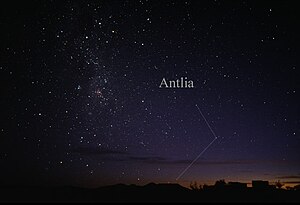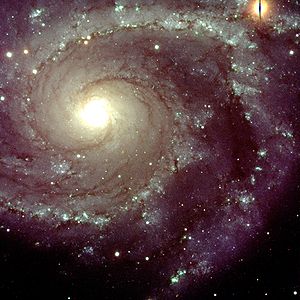alunwynhalen/Antlia
| Cytser | |
 Rhestr o sêr yn Antlia | |
| Byrfodd | Ant |
|---|---|
| Cyflwr genidol | Antliae |
| Ynganiad | /ˈæntliə/, genitive /ˈæntlɪ.iː/ |
| Symboliaeth | y pwmp awyr |
| Esgyniad cywir | 09h 27m 05.1837s–11h 05m 55.0471s |
| Gogwydd | −24.5425186°–−40.4246216° |
| Teulu | La Caille |
| Arwynebedd | 239 deg. sg. (62eg) |
| Prif Sêr | 3 |
| Dynodiad Bayer/ Flamsteed sêr | 9 |
| Sêr gyda phlanedau | 2 |
| Sêr goleuach na 3.00m | 0 |
| Sêr o fewn 10.00 pc (32.62 blwydd gol.) | 2 |
| Seren fwyaf llachar | α Ant (4.25m) |
| Seren agosaf | DEN 1048-3956 (13.17 ly, 4.04 pc) |
| Gwrthrychau Messier | 0 |
| Cawodydd o sêr gwib | Dim |
| Cytser cyfagos | Hydra Pyxis Vela Centaurus |
| Yn weladwy ar +45fed Paralel Gogleddol° a −90°. Mwayf gweladwy am 21:00 (9 y. h.) yn ystod mis Ebrill. | |
Antlia (/ˈæntliə/; from Ancient Greek ἀντλία) is a constellation in the southern sky. Its name means "pump" and it specifically represents an air pump. The constellation was created in the 18th century from an undesignated region of sky, so the stars comprising Antlia are faint. Antlia is bordered by Hydra the sea snake, Pyxis the compass, Vela the sails, and Centaurus the centaur. This group of constellations is prominent in the southern sky in late winter and spring. NGC 2997, a spiral galaxy, and the Antlia Dwarf Galaxy lie within Antlia's borders.
History

Antlia was created in 1756 by the French astronomer Abbé Nicolas Louis de Lacaille, who created fourteen constellations for the southern sky to fill some faint regions. Though Antlia was technically visible to ancient Greek astronomers, its stars were too faint to have been included in any constellations. Because of this, its main stars have no particular pattern and it is devoid of bright deep-sky objects. It was originally named Antlia pneumatica ("Machine Pneumatique" in French) to commemorate the air pump invented by the French physicist Denis Papin.
Lacaille and Johann Bode each depicted Antlia differently, as either the single-cylinder vacuum pump used in Papin's initial experiments, or the more advanced double-cylinder version. The International Astronomical Union subsequently adopted it as one of the 88 modern constellations. There is no mythology attached to Antlia as Lacaille discontinued the tradition of giving names from mythology to constellations and instead chose names mostly from scientific instruments.
According to some, the most prominent stars that now comprise Antlia were once included within the ancient constellation Argo Navis, the Ship of the Argonauts, which due to its immense size was split into several smaller constellations by Lacaille in 1763. However, given the faintness and obscurity of its stars, most authorities do not believe that the ancient Greeks included Antlia as part of their classical depiction of Argo Navis.
In non-Western astronomy
Chinese astronomers were able to view what is modern Antlia from their latitudes, and incorporated its stars into two different constellations. Several stars in the southern part of Antlia were a portion of "Dong'ou", which represented an area in southern China. Furthermore, Epsilon, Eta, and theta Antliae were incorporated into the celestial temple, which also contained stars from modern Pyxis.
Notable features

Stars
Lacaille gave nine stars Bayer designations, labelling them Alpha through to Theta, including two stars next to each other as Zeta. Gould later added a tenth, Iota Antliae. Beta and Gamma Antliae (now HR 4339 and HD 90156) ended up in the neighbouring constellation Hydra once the constellation boundaries were delineated in 1930.
The constellation's brightest star, Alpha Antliae is an orange giant of spectral type K4III that is a suspected variable star, ranging between apparent magnitudes 4.22 and 4.29. It is located 366 light-years away from Earth. Estimated to be shining with around 480 to 555 times the luminosity of the Sun, it is most likely an ageing star that is brightening and on its way to becoming a Mira variable star, having converted all its core fuel into carbon. Located near Alpha is Delta Antliae, a binary star around 481 light years distant. The primary is a blue-white main sequence star of spectral type B9.5V and magnitude 5.6 and the secondary is an yellow-white main sequence star of spectral type F9Ve and magnitude 9.6.
Zeta Antliae is a wide double star 373 light years away. The primary (Zeta1 Antliae) is of magnitude 5.8, though it is a double star with a primary of magnitude 6.2 and a secondary of magnitude 7.0. The secondary (Zeta2 Antliae) is of magnitude 5.9. Eta Antliae is another double composed of an F-type main sequence star of spectral type and magnitude 5.22, with a companion of magnitude 11.3. Theta Antliae is likewise double, composed of an A-type main sequence star and yellow giant.
Epsilon Antliae is an evolved orange giant star of spectral type K3 IIIa, with a diameter around 69 times that of the Sun. It is slightly variable. At the other end of Antlia, Iota Antliae is likewise an orange giant of spectral type K1 III.
T Antliae is a yellow-white supergiant of spectral type F6Iab and Cepheid variable ranging between magnitude 8.88 and 9.82. U Antliae is a red C-type carbon star and is an irregular variable that ranges between magnitudes 5.27 and 6.04.
HR 4049, also known as AG Antliae, is an unusual hot variable ageing star of spectral type B9.5Ib-II. UX Antliae is an R Coronae Borealis variable with a baseline apparent magnitude of around 11.85, with irregular dimmings down to below magnitude 18.0. A luminous and remote star, it is a supergiant with a spectrum resembling that of a yellow-white F-type star but it has almost no hydrogen.
DEN 1048-3956 is a brown dwarf located around 13 light-years distant from Earth. At magnitude 17 it is much too faint to be seen with the unaided eye.
Deep-sky objects

Because it occupies a part of the celestial sphere that faces away from the Milky Way, Antlia contains very few deep-sky objects. It contains no globular clusters, no planetary nebulae, and no open clusters. However, it does contain several galaxies.
NGC 2997 is a loose face-on spiral galaxy of type Sc. It is the brightest galaxy in Antlia at an integrated magnitude of 10.6. Though nondescript in most amateur telescopes, it presents bright clusters of young stars and many dark dust lanes in photographs.
The Antlia Dwarf, a 14.8m dwarf spheroidal galaxy that belongs to our Local Group of galaxies. It was discovered only as recently as 1997.
The Antlia Cluster is a cluster of galaxies located in the Hydra-Centaurus Supercluster. It is the third nearest to our Local Group after the Virgo Cluster and Fornax Cluster.
References
- Citations
- References
External links
 | Look up [[[:Nodyn:Sec link/relative url]] antlia] in Wiktionary, the free dictionary. |
This article uses material from the Wikipedia Cymraeg article Antlia, which is released under the Creative Commons Attribution-ShareAlike 3.0 license ("CC BY-SA 3.0"); additional terms may apply (view authors). Rhoddir testun y dudalen ar gael ar delerau'r drwydded CC BY-SA 4.0, heblaw ei fod wedi nodi'n wahanol. Images, videos and audio are available under their respective licenses.
®Wikipedia is a registered trademark of the Wiki Foundation, Inc. Wiki Cymraeg (DUHOCTRUNGQUOC.VN) is an independent company and has no affiliation with Wiki Foundation.
